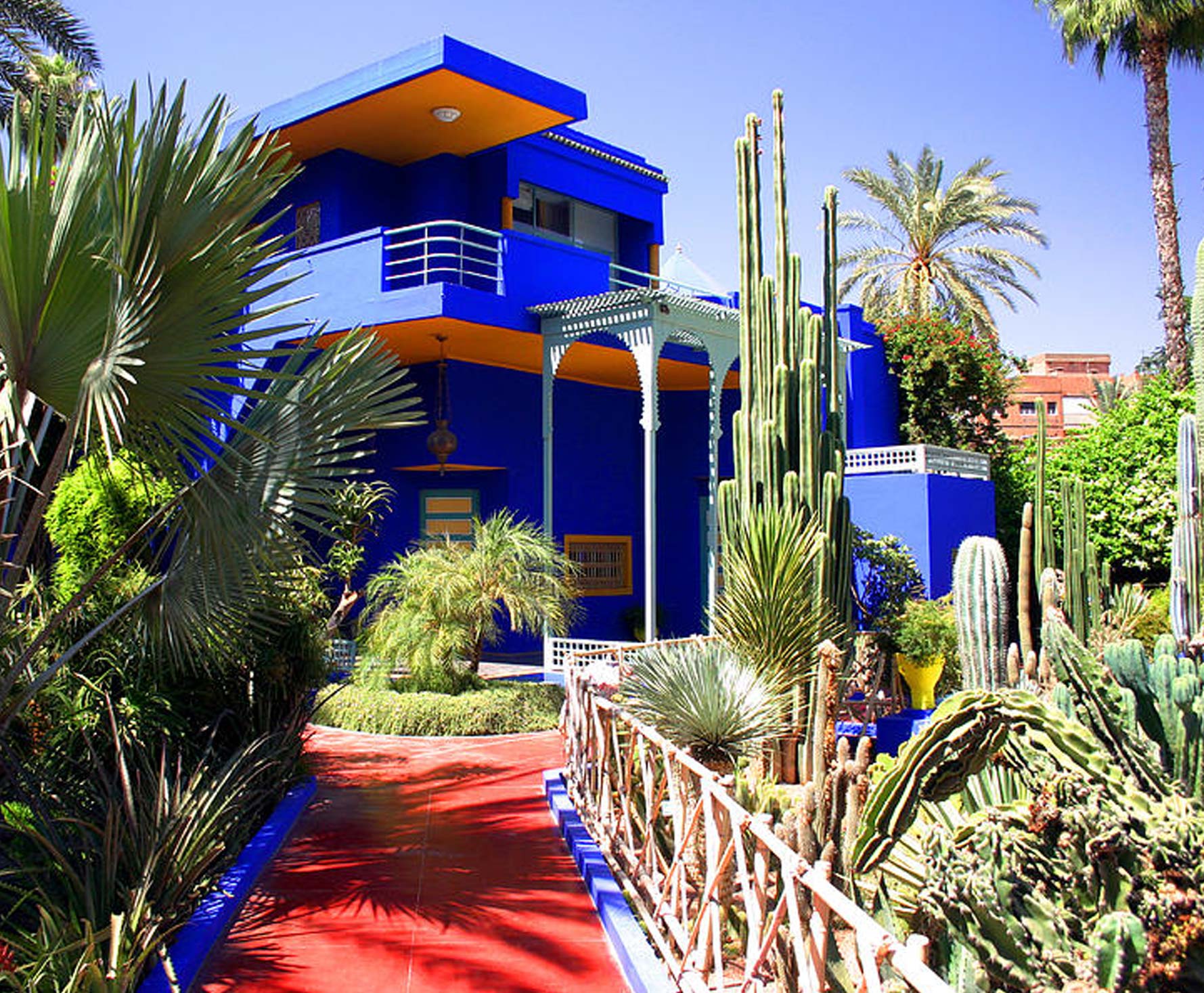The Majorelle Garden (Jardin Majorelle) previously the Jardin Bou Saf, was designed by the French expatriate artist Jacques Majorelle in 1924. Jacques Majorelle was the son of the celebrated Art Nouveau furniture designer Louis Majorelle. He studied at the École des Beaux-Arts in Nancy in 1901 and later in 1919 he went to Marrakech, Morocco to recover from heart problems. He built the garden during those years using special colour of blue which he used extensively in the garden that is named after him, Majorelle Blue. Jacques Majorelle returned to France in 1962 after a car incident and died later that year of complications from his injuries. Even though Morocco is no longer under the French protectorate, this originally French creation is one of the most beloved areas in Morocco.
The subtropical Majorelle Garden is located in the heart of Gueliz, Hivernage within the Imperial city of Marrakech. It is one of the most delightful and stunning spots within this red walled city. To arrive at this meticulously designed botanical garden you must pass through Marrakech’s medina filled with acres of olive groves and palms.

The garden has been open to the public since 1947. Since 1980 the garden has been owned by Yves Saint-Laurent and Pierre Bergé. After Yves Saint Laurent died in 2008 his ashes were scattered in the Majorelle Garden. The Fondation Bergé is one of the most important support to moroccan contemporary scene.
MEDERSA BEN YOUSSEF
You who enter my door, may your highest hopes be exceeded’ reads the inscription over the entryway to the Ali ben Youssef Medersa, and after almost six centuries, the blessing still works its charms on visitors. Founded in the 14th century under the Merenids, this Quranic learning centre was once the largest in North Africa, and remains among the most splendid.
Entry & Courtyard
Sight lines and spirits are lifted in the entry with carved Atlas cedar cupolas and mashrabiyya (wooden-lattice screen) balconies. The medersa’s courtyard is a mind-boggling profusion of Hispano-Moresque ornament: five-colour zellij (mosaic) walls; stucco archways, with Iraqi-style Kufic letters ending in leaves; cedar windows with weather-worn carved vines; and a curved mihrab (eastern-facing niche) of prized, milky-white Italian Carrara marble.


PALAIS DE LA BAHIA


The Bahia Palace is both a palace and a set of gardens situated in the medina of Marrakech, Morocco, just along the northern edge of Mellah, also known as the Jewish Quarter. While the exact dates for the construction of this palace are not known, records indicate that it was commissioned between 1859 and 1873. It was completed in 1900. It was intended to serve the personal uses of the sultan. In fact, the palace also bore the name of one of his wives.
His harem was housed here, and it included an enormous court decorated with a central basin with the concubines dwelling in a series of surrounding rooms. The whole complex is quite large, covering eight hectares. It is comprised of a series of walled gardens, pavilions and courtyard structures arranged in various scales.
MOSQUÉE DE LA KOUTOUBIA

The Koutoubia Mosque, located in Marrakesh’s Djemaa el Fna Square, is a landmark and the largest mosque in Marrakesh, Morocco. Built during the Hispano-Moresque period, characteristic of simple yet masterful craftsmanship and luxury, The Koutoubia Mosque is argued to be most beautiful and proportioned mosque in the world.
The Koutoubia Mosque was completed under the reign of the Almohad dynasty Caliph Yaqub al-Mansur (1184–1199). The name is derived from the Arabic al-Koutoubiyyin for librarian, since it used to be surrounded by sellers of manuscripts. Koutoubia Mosque, is often referred to in literature as the “bookseller’s mosque” and was named after the souk of koutoubiyyin, where sellers of manuscripts in the twelfth and thirteenth centuries laid out books and scripts on stalls on front of the original mosque.
PALAIS EL BADI
The El Badi Palace is an open-air account of the successive dynasties which have held sway in Marrakech. It was built in the late 16th century by King Ahmad al-Mansur of the Saadi dynasty, who spared no expense, filling his home with the best materials and craftsmanship of the age: Italian marble, Sudanese gold and intricately carved Indian woodwork.
But the glories of El Badi (“the incomparable”) were fleeting, and Sultan Mawlay Ismail of the succeeding Alaouite dynasty ransacked the building for his own palace. Even in its ruined state you get a clear idea of the scale of the palace, with high, stark walls enclosing the traces of stately reception halls and other official chambers. The intricate Koutobia minbar (the pulpit-like stairway from which the imam preaches in the mosque) is also on display.


PLACE JEMAA EL-FNA
The famous town square of Marrakech, Jemaa l-Fna, owes little of its fame to its own beauty, but to the continuous day and night life. During most of the days, perfomers of every kind put up their shows, continuing until the food stalls start to move in.
The food is exquisite, tasteful and much appreciated by Moroccans and brave tourists. We specially recommend the food stall number 98!


